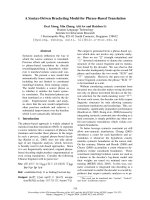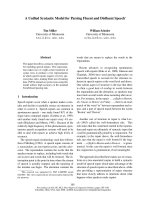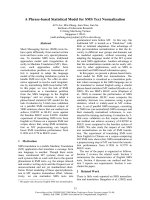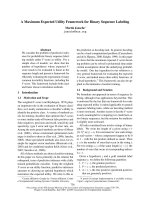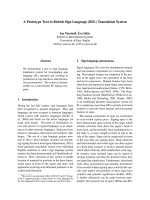Báo cáo khoa học: "A Joint Rule Selection Model for Hierarchical Phrase-based Translation" pptx
Bạn đang xem bản rút gọn của tài liệu. Xem và tải ngay bản đầy đủ của tài liệu tại đây (228.03 KB, 6 trang )
Proceedings of the ACL 2010 Conference Short Papers, pages 6–11,
Uppsala, Sweden, 11-16 July 2010.
c
2010 Association for Computational Linguistics
A Joint Rule Selection Model for Hierarchical Phrase-based Translation
∗
Lei Cui
†
, Dongdong Zhang
‡
, Mu Li
‡
, Ming Zhou
‡
, and Tiejun Zhao
†
†
School of Computer Science and Technology
Harbin Institute of Technology, Harbin, China
{cuilei,tjzhao}@mtlab.hit.edu.cn
‡
Microsoft Research Asia, Beijing, China
{dozhang,muli,mingzhou}@microsoft.com
Abstract
In hierarchical phrase-based SMT sys-
tems, statistical models are integrated to
guide the hierarchical rule selection for
better translation performance. Previous
work mainly focused on the selection of
either the source side of a hierarchical rule
or the target side of a hierarchical rule
rather than considering both of them si-
multaneously. This paper presents a joint
model to predict the selection of hierar-
chical rules. The proposed model is esti-
mated based on four sub-models where the
rich context knowledge from both source
and target sides is leveraged. Our method
can be easily incorporated into the prac-
tical SMT systems with the log-linear
model framework. The experimental re-
sults show that our method can yield sig-
nificant improvements in performance.
1 Introduction
Hierarchical phrase-based model has strong ex-
pression capabilities of translation knowledge. It
can not only maintain the strength of phrase trans-
lation in traditional phrase-based models (Koehn
et al., 2003; Xiong et al., 2006), but also char-
acterize the complicated long distance reordering
similar to syntactic based statistical machine trans-
lation (SMT) models (Yamada and Knight, 2001;
Quirk et al., 2005; Galley et al., 2006; Liu et al.,
2006; Marcu et al., 2006; Mi et al., 2008; Shen et
al., 2008).
In hierarchical phrase-based SMT systems, due
to the flexibility of rule matching, a huge number
of hierarchical rules could be automatically learnt
from bilingual training corpus (Chiang, 2005).
SMT decoders are forced to face the challenge of
∗
This work was finished while the first author visited Mi-
crosoft Research Asia as an intern.
proper rule selection for hypothesis generation, in-
cluding both source-side rule selection and target-
side rule selection where the source-side rule de-
termines what part of source words to be translated
and the target-side rule provides one of the candi-
date translations of the source-side rule. Improper
rule selections may result in poor translations.
There is some related work about the hierarchi-
cal rule selection. In the original work (Chiang,
2005), the target-side rule selection is analogous to
the model in traditional phrase-based SMT system
such as Pharaoh (Koehn et al., 2003). Extending
this work, (He et al., 2008; Liu et al., 2008) in-
tegrate rich context information of non-terminals
to predict the target-side rule selection. Different
from the above work where the probability dis-
tribution of source-side rule selection is uniform,
(Setiawan et al., 2009) proposes to select source-
side rules based on the captured function words
which often play an important role in word re-
ordering. There is also some work considering to
involve more rich contexts to guide the source-side
rule selection. (Marton and Resnik, 2008; Xiong
et al., 2009) explore the source syntactic informa-
tion to reward exact matching structure rules or
punish crossing structure rules.
All the previous work mainly focused on either
source-side rule selection task or target-side rule
selection task rather than both of them together.
The separation of these two tasks, however, weak-
ens the high interrelation between them. In this pa-
per, we propose to integrate both source-side and
target-side rule selection in a unified model. The
intuition is that the joint selection of source-side
and target-side rules is more reliable as it conducts
the search in a larger space than the single selec-
tion task does. It is expected that these two kinds
of selection can help and affect each other, which
may potentially lead to better hierarchical rule se-
lections with a relative global optimum instead of
a local optimum that might be reached in the pre-
6
vious methods. Our proposed joint probability
model is factored into four sub-models that can
be further classified into source-side and target-
side rule selection models or context-based and
context-free selection models. The context-based
models explore rich context features from both
source and target sides, including function words,
part-of-speech (POS) tags, syntactic structure in-
formation and so on. Our model can be easily in-
corporated as an independent feature into the prac-
tical hierarchical phrase-based systems with the
log-linear model framework. The experimental re-
sults indicate our method can improve the system
performance significantly.
2 Hierarchical Rule Selection Model
Following (Chiang, 2005), α, γ is used to repre-
sent a synchronous context free grammar (SCFG)
rule extracted from the training corpus, where α
and γ are the source-side and target-side rule re-
spectively. Let C be the context of α, γ. For-
mally, our joint probability model of hierarchical
rule selection is described as follows:
P (α, γ|C) = P (α|C)P (γ|α, C) (1)
We decompose the joint probability model into
two sub-models based on the Bayes formulation,
where the first sub-model is source-side rule se-
lection model and the second one is the target-side
rule selection model.
For the source-side rule selection model, we fur-
ther compute it by the interpolation of two sub-
models:
θP
s
(α) + (1 − θ)P
s
(α|C) (2)
where P
s
(α) is the context-free source model
(CFSM) and P
s
(α|C) is the context-based source
model (CBSM), θ is the interpolation weight that
can be optimized over the development data.
CFSM is the probability of source-side rule se-
lection that can be estimated based on maximum
likelihood estimation (MLE) method:
P
s
(α) =
γ
Count(α, γ)
Count(α)
(3)
where the numerator is the total count of bilin-
gual rule pairs with the same source-side rule that
are extracted based on the extraction algorithm in
(Chiang, 2005), and the denominator is the total
amount of source-side rule patterns contained in
the monolingual source side of the training corpus.
CFSM is used to capture how likely the source-
side rule is linguistically motivated or has the cor-
responding target-side counterpart.
For CBSM, it can be naturally viewed as a clas-
sification problem where each distinct source-side
rule is a single class. However, considering the
huge number of classes may cause serious data
sparseness problem and thereby degrade the clas-
sification accuracy, we approximate CBSM by a
binary classification problem which can be solved
by the maximum entropy (ME) approach (Berger
et al., 1996) as follows:
P
s
(α|C) ≈ P
s
(υ|α, C)
=
exp[
i
λ
i
h
i
(υ, α, C)]
υ
exp[
i
λ
i
h
i
(υ
, α, C)]
(4)
where υ ∈ {0, 1} is the indicator whether the
source-side rule is applied during decoding, υ = 1
when the source-side rule is applied, otherwise
υ = 0; h
i
is a feature function, λ
i
is the weight
of h
i
. CBSM estimates the probability of the
source-side rule being selected according to the
rich context information coming from the surface
strings and sub-phrases that will be reduced to
non-terminals during decoding.
Analogously, we decompose the target-side rule
selection model by the interpolation approach as
well:
ϕP
t
(γ) + (1 − ϕ)P
t
(γ|α, C) (5)
where P
t
(γ) is the context-free target model
(CFTM) and P
t
(γ|α, C) is the context-based tar-
get model (CBTM), ϕ is the interpolation weight
that can be optimized over the development data.
In the similar way, we compute CFTM by the
MLE approach and estimate CBTM by the ME
approach. CFTM computes how likely the target-
side rule is linguistically motivated, while CBTM
predicts how likely the target-side rule is applied
according to the clues from the rich context infor-
mation.
3 Model Training of CBSM and CBTM
3.1 The acquisition of training instances
CBSM and CBTM are trained by ME approach for
the binary classification, where a training instance
consists of a label and the context related to SCFG
rules. The context is divided into source context
7
Figure 1: Example of training instances in CBSM and CBTM.
and target context. CBSM is trained only based
on the source context while CBTM is trained over
both the source and the target context. All the
training instances are automatically constructed
from the bilingual training corpus, which have la-
bels of either positive (i.e., υ = 1) or negative (i.e.,
υ = 0). This section explains how the training in-
stances are constructed for the training of CBSM
and CBTM.
Let s and t be the source sentence and target
sentence, W be the word alignment between them,
r
s
be a source-side rule that pattern-matches a
sub-phrase of s, r
t
be the target-side rule pattern-
matching a sub-phrase of t and being aligned to r
s
based on W , and C(r) be the context features re-
lated to the rule r which will be explained in the
following section.
For the training of CBSM, if the SCFG rule
r
s
, r
t
can be extracted based on the rule extrac-
tion algorithm in (Chiang, 2005), υ = 1, C(r
s
)
is constructed as a positive instance, otherwise
υ = 0, C(r
s
) is constructed as a negative in-
stance. For example in Figure 1(a), the context of
source-side rule ”X
1
hezuo” that pattern-matches
the phrase ”youhao hezuo” produces a positive
instance, while the context of ”X
1
youhao” that
pattern-matches the source phrase ”de youhao” or
”shuangfang de youhao” will produce a negative
instance as there are no corresponding plausible
target-side rules that can be extracted legally
1
.
For the training of CBTM, given r
s
, suppose
there is a SCFG rule set {r
s
, r
k
t
|1 ≤ k ≤ n}
extracted from multiple distinct sentence pairs in
the bilingual training corpus, among which we as-
sume r
s
, r
i
t
is extracted from the sentence pair
s, t. Then, we construct υ = 1, C(r
s
), C(r
i
t
)
1
Because the aligned target words are not contiguous and
”cooperation” is aligned to the word outside the source-side
rule.
as a positive instance, while the elements in {υ =
0, C(r
s
), C(r
j
t
)|j = i ∧ 1 ≤ j ≤ n} are viewed
as negative instances since they fail to be applied
to the translation from s to t. For example in Fig-
ure 1(c), Rule (1) and Rule (2) are two different
SCFG rules extracted from Figure 1(a) and Figure
1(b) respectively, where their source-side rules are
the same. As Rule (1) cannot be applied to Fig-
ure 1(b) for the translation and Rule (2) cannot
be applied to Figure 1(a) for the translation either,
υ = 1, C(r
a
s
), C(r
a
t
) and υ = 1, C(r
b
s
), C(r
b
t
)
are constructed as positive instances while υ =
0, C(r
a
s
), C(r
b
t
) and υ = 0, C(r
b
s
), C(r
a
t
) are
viewed as negative instances. It is noticed that
this instance construction method may lead to a
large quantity of negative instances and choke the
training procedure. In practice, to limit the size
of the training set, the negative instances con-
structed based on low-frequency target-side rules
are pruned.
3.2 Context-based features for ME training
ME approach has the merit of easily combining
different features to predict the probability of each
class. We incorporate into the ME based model
the following informative context-based features
to train CBSM and CBTM. These features are
carefully designed to reduce the data sparseness
problem and some of them are inspired by pre-
vious work (He et al., 2008; Gimpel and Smith,
2008; Marton and Resnik, 2008; Chiang et al.,
2009; Setiawan et al., 2009; Shen et al., 2009;
Xiong et al., 2009):
1. Function word features, which indicate
whether the hierarchical source-side/target-
side rule strings and sub-phrases covered by
non-terminals contain function words that are
often important clues of predicting syntactic
structures.
8
2. POS features, which are POS tags of the
boundary source words covered by non-
terminals.
3. Syntactic features, which are the constituent
constraints of hierarchical source-side rules
exactly matching or crossing syntactic sub-
trees.
4. Rule format features, which are non-
terminal positions and orders in source-
side/target-side rules. This feature interacts
between source and target components since
it shows whether the translation ordering is
affected.
5. Length features, which are the length
of sub-phrases covered by source non-
terminals.
4 Experiments
4.1 Experiment setting
We implement a hierarchical phrase-based system
similar to the Hiero (Chiang, 2005) and evaluate
our method on the Chinese-to-English translation
task. Our bilingual training data comes from FBIS
corpus, which consists of around 160K sentence
pairs where the source data is parsed by the Berke-
ley parser (Petrov and Klein, 2007). The ME train-
ing toolkit, developed by (Zhang, 2006), is used to
train our CBSM and CBTM. The training size of
constructed positive instances for both CBSM and
CBTM is 4.68M, while the training size of con-
structed negative instances is 3.74M and 3.03M re-
spectively. Following (Setiawan et al., 2009), we
identify function words as the 128 most frequent
words in the corpus. The interpolation weights are
set to θ = 0.75 and ϕ = 0.70. The 5-gram lan-
guage model is trained over the English portion
of FBIS corpus plus Xinhua portion of the Giga-
word corpus. The development data is from NIST
2005 evaluation data and the test data is from
NIST 2006 and NIST 2008 evaluation data. The
evaluation metric is the case-insensitive BLEU4
(Papineni et al., 2002). Statistical significance in
BLEU score differences is tested by paired boot-
strap re-sampling (Koehn, 2004).
4.2 Comparison with related work
Our baseline is the implemented Hiero-like SMT
system where only the standard features are em-
ployed and the performance is state-of-the-art.
We compare our method with the baseline and
some typical approaches listed in Table 1 where
XP+ denotes the approach in (Marton and Resnik,
2008) and TOFW (topological ordering of func-
tion words) stands for the method in (Setiawan et
al., 2009). As (Xiong et al., 2009)’s work is based
on phrasal SMT system with bracketing transduc-
tion grammar rules (Wu, 1997) and (Shen et al.,
2009)’s work is based on the string-to-dependency
SMT model, we do not implement these two re-
lated work due to their different models from ours.
We also do not compare with (He et al., 2008)’s
work due to its less practicability of integrating
numerous sub-models.
Methods NIST 2006 NIST 2008
Baseline 0.3025 0.2200
XP+ 0.3061 0.2254
TOFW 0.3089 0.2253
Our method 0.3141 0.2318
Table 1: Comparison results, our method is signif-
icantly better than the baseline, as well as the other
two approaches (p < 0.01)
As shown in Table 1, all the methods outper-
form the baseline because they have extra mod-
els to guide the hierarchical rule selection in some
ways which might lead to better translation. Ap-
parently, our method also performs better than the
other two approaches, indicating that our method
is more effective in the hierarchical rule selection
as both source-side and target-side rules are se-
lected together.
4.3 Effect of sub-models
Due to the space limitation, we analyze the ef-
fect of sub-models upon the system performance,
rather than that of ME features, part of which have
been investigated in previous related work.
Settings NIST 2006 NIST 2008
Baseline 0.3025 0.2200
Baseline+CFSM 0.3092
∗
0.2266
∗
Baseline+CBSM 0.3077
∗
0.2247
∗
Baseline+CFTM 0.3076
∗
0.2286
∗
Baseline+CBTM 0.3060 0.2255
∗
Baseline+CFSM+CFTM 0.3109
∗
0.2289
∗
Baseline+CFSM+CBSM 0.3104
∗
0.2282
∗
Baseline+CFTM+CBTM 0.3099
∗
0.2299
∗
Baseline+all sub-models 0.3141
∗
0.2318
∗
Table 2: Sub-model effect upon the performance,
*: significantly better than baseline (p < 0.01)
As shown in Table 2, when sub-models are inte-
9
grated as independent features, the performance is
improved compared to the baseline, which shows
that each of the sub-models can improve the hier-
archical rule selection. It is noticeable that the per-
formance of the source-side rule selection model
is comparable with that of the target-side rule se-
lection model. Although CFSM and CFTM per-
form only slightly better than the others among
the individual sub-models, the best performance is
achieved when all the sub-models are integrated.
5 Conclusion
Hierarchical rule selection is an important and
complicated task for hierarchical phrase-based
SMT system. We propose a joint probability
model for the hierarchical rule selection and the
experimental results prove the effectiveness of our
approach.
In the future work, we will explore more useful
features and test our method over the large scale
training corpus. A challenge might exist when
running the ME training toolkit over a big size
of training instances from the large scale training
data.
Acknowledgments
We are especially grateful to the anonymous re-
viewers for their insightful comments. We also
thank Hendra Setiawan, Yuval Marton, Chi-Ho Li,
Shujie Liu and Nan Duan for helpful discussions.
References
Adam L. Berger, Vincent J. Della Pietra, and Stephen
A. Della Pietra. 1996. A Maximum Entropy Ap-
proach to Natural Language Processing. Computa-
tional Linguistics, 22(1): pages 39-72.
David Chiang. 2005. A Hierarchical Phrase-Based
Model for Statistical Machine Translation. In Proc.
ACL, pages 263-270.
David Chiang, Kevin Knight, and Wei Wang. 2009.
11,001 New Features for Statistical Machine Trans-
lation. In Proc. HLT-NAACL, pages 218-226.
Michel Galley, Jonathan Graehl, Kevin Knight, Daniel
Marcu, Steve DeNeefe, Wei Wang, and Ignacio
Thayer. 2006. Scalable Inference and Training of
Context-Rich Syntactic Translation Models. In Proc.
ACL-Coling, pages 961-968.
Kevin Gimpel and Noah A. Smith. 2008. Rich Source-
Side Context for Statistical Machine Translation. In
Proc. the Third Workshop on Statistical Machine
Translation, pages 9-17.
Zhongjun He, Qun Liu, and Shouxun Lin. 2008. Im-
proving Statistical Machine Translation using Lexi-
calized Rule Selection. In Proc. Coling, pages 321-
328.
Philipp Koehn. 2004. Statistical Significance Tests for
Machine Translation Evaluation. In Proc. EMNLP.
Philipp Koehn, Franz J. Och, and Daniel Marcu. 2003.
Statistical Phrase-Based Translation. In Proc. HLT-
NAACL, pages 127-133.
Qun Liu, Zhongjun He, Yang Liu, and Shouxun Lin.
2008. Maximum Entropy based Rule Selection
Model for Syntax-based Statistical Machine Trans-
lation. In Proc. EMNLP, pages 89-97.
Yang Liu, Yun Huang, Qun Liu, and Shouxun Lin.
2007. Forest-to-String Statistical Translation Rules.
In Proc. ACL, pages 704-711.
Yang Liu, Qun Liu, and Shouxun Lin. 2006. Tree-to-
String Alignment Template for Statistical Machine
Translation. In Proc. ACL-Coling, pages 609-616.
Daniel Marcu, Wei Wang, Abdessamad Echihabi, and
Kevin Knight. 2006. SPMT: Statistical Ma-
chine Translation with Syntactified Target Language
Phrases. In Proc. EMNLP, pages 44-52.
Yuval Marton and Philip Resnik. 2008. Soft Syntactic
Constraints for Hierarchical Phrased-Based Trans-
lation. In Proc. ACL, pages 1003-1011.
Haitao Mi, Liang Huang, and Qun Liu. 2008. Forest-
Based Translation. In Proc. ACL, pages 192-199.
Kishore Papineni, Salim Roukos, Todd Ward, and Wei-
Jing Zhu. 2002. Bleu: a Method for Automatic
Evaluation of Machine Translation. In Proc. ACL,
pages 311-318.
Slav Petrov and Dan Klein. 2007. Improved Inference
for Unlexicalized Parsing. In Proc. HLT-NAACL,
pages 404-411.
Chris Quirk, Arul Menezes, and Colin Cherry. 2005.
Dependency Treelet Translation: Syntactically In-
formed Phrasal SMT. In Proc. ACL, pages 271-279.
Libin Shen, Jinxi Xu, and Ralph Weischedel. 2008. A
New String-to-Dependency Machine Translation Al-
gorithm with a Target Dependency Language Model.
In Proc. ACL, pages 577-585.
Libin Shen, Jinxi Xu, Bing Zhang, Spyros Matsoukas,
and Ralph Weischedel. 2009. Effective Use of Lin-
guistic and Contextual Information for Statistical
Machine Translation. In Proc. EMNLP, pages 72-
80.
Hendra Setiawan, Min Yen Kan, Haizhou Li, and Philip
Resnik. 2009. Topological Ordering of Function
Words in Hierarchical Phrase-based Translation. In
Proc. ACL, pages 324-332.
10
Dekai Wu. 1997. Stochastic Inversion Transduction
Grammars and Bilingual Parsing of Parallel Cor-
pora. Computational Linguistics, 23(3): pages 377-
403.
Deyi Xiong, Qun Liu, and Shouxun Lin. 2006. Maxi-
mum Entropy Based Phrase Reordering Model for
Statistical Machine Translation. In Proc. ACL-
Coling, pages 521-528.
Deyi Xiong, Min Zhang, Aiti Aw, and Haizhou Li.
2009. A Syntax-Driven Bracketing Model for
Phrase-Based Translation. In Proc. ACL, pages
315-323.
Kenji Yamada and Kevin Knight. 2001. A Syntax-
based Statistical Translation Model. In Proc. ACL,
pages 523-530.
Le Zhang. 2006. Maximum entropy mod-
eling toolkit for python and c++. avail-
able at />lzhang10/maxent_toolkit.html.
11


